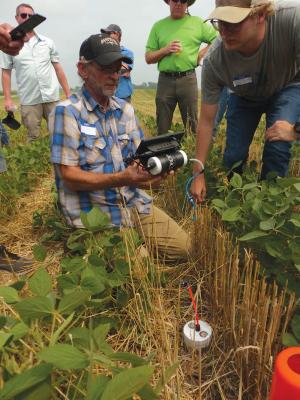2021 - Volume #45, Issue #5, Page #27
[ Sample Stories From This Issue | List of All Stories In This Issue | Print this story
| Read this issue]
Soil Health Tool Talks Back
 |
“The more CO2 released from your soil and thus detected by our sensors, the healthier your soil,” says Jason Snavely, co-developer of the GNT Bio Machine with Dr. Rick Haney. “Consultants using the Soil Talker commonly see CO2 readings of 1,000 to 1,200 parts per million (ppm) in conventionally tilled fields. No-till, cover cropped fields will produce readings in the 4,000 to 6,000 ppm range.”
Until his recent retirement Haney was with the USDA, where he developed what is known as the Haney Soil Health Test. It has been used by tens of thousands of farmers and ranchers to help them manage soil health and their crop production systems. An important element of the test was the 24-hr. CO2 Burst test. The Soil Talker provides the same results in seconds.
“Our latest version utilizes a small pump that pulls the CO2 across the sensor for an instant reading,” says Snavely.
The Bio Machine refers to the instrument with its CO2 sensor, a microprocessor and a digital display for the results. The GNT portion of the system is a tube or chamber that is inserted in the soil. It provides a space for ambient CO2 in the soil to pass through. As levels change in the soil, they change in the chamber, thanks to holes of a specific size, location and number.
“Data collected from GNT Bio Machines scattered around the country has been calibrated to more than 45,000 results from the Haney Soil Health Test,” says Snavely. “Our standard sensor evaluates CO2 at levels of up to 10,000 ppm. However, one client had soils with a reading of 17,000 ppm. A growing number of regenerative farms are testing at levels above 10,000. As a result, we plan to offer sensors that read up to 100,000 ppm.”
At this point, he describes the Soil Talker as a tool in the art of farming, providing insights and disclosing trends over time. He suggests using the tool to compare soils in fields managed differently or even in fence rows. “Look at the reading you get in a conventionally managed field,” says Snavely. “Compare it to one from a no-tilled field with cover crops and one from a fence row.”
In the future, the tool will include more definitive information. Haney, Snavely and their network of soil consultant cooperators now working with the tool are developing applications that include assessing organic N, carbon, soil structure/water infiltration rates and more. The first two involve calibrating readings to data from the Haney Soil Health Test and use the existing GNT soil chamber.
The Soil Structure Microbial Activity Test (S2MAT)evaluates soil structure based on microbial respiration before and after a rainfall. It will utilize a specially developed soil chamber.
“CO2 respiration is inhibited when soil pore spaces fill with water,” explains Haney. “CO2 that increases immediately after a rainfall is indicative of excellent infiltration and soil structure.”
The GNT Bio Machine or Soil Talker is only available in limited quantity by special order from Snavely’s Drop-Tine Seed Co. This is likely to change in the future, as demand is rapidly ramping up. The co-developers are establishing a new company devoted specifically to the Soil Talker.
Some aspects of the Soil Talker (including a website) are still being refined; however, as it is today, Snavely anticipates a price of around $3,500.
Contact: FARM SHOW Followup, Drop-Tine Seed Co., 56 Oman Rd., Bloomsburg, Penn. 17815 (ph 570 204-4064; Jason@droptineseed.com).

Click here to download page story appeared in.

Click here to read entire issue
To read the rest of this story, download this issue below or click here to register with your account number.




